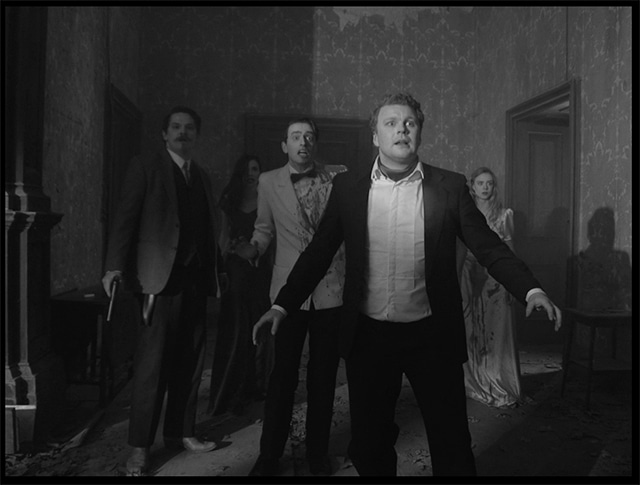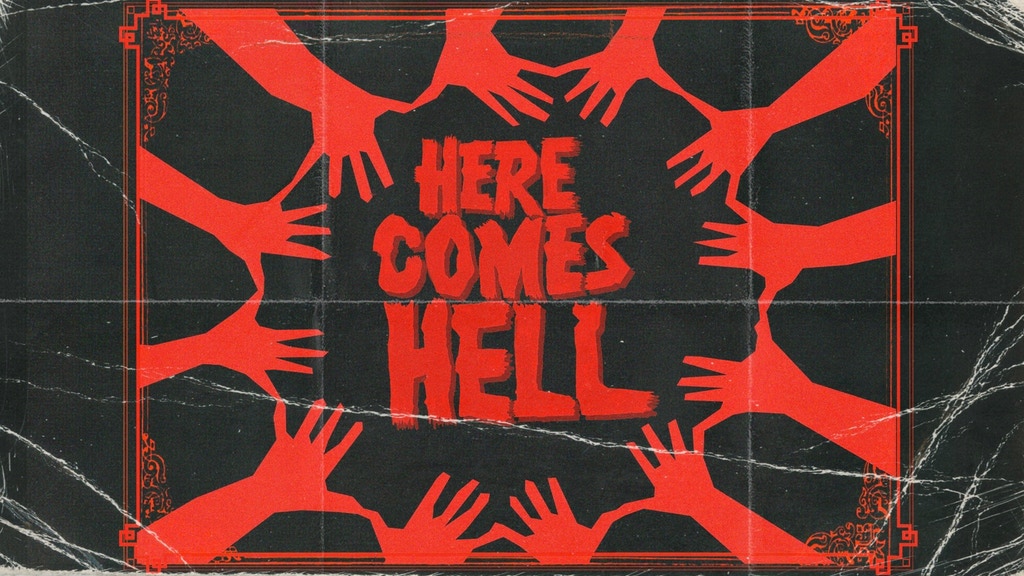
Have you ever sat through one of those Old Dark House style movies, where everyone speaks in RP and smokes continuously through ornate cigarette holders, and thought to yourself – this is fun, but wouldn’t it be glorious if the social niceties and subtly barbed comments gave way to something else entirely? We’ve had a few genre mash-ups in past years, starting with Pride and Prejudice and Zombies, and now it seems that we’ve moved out of the 19th Century and into the 20th. So we come to Here Comes Hell, an Agatha Christie-style meeting of friends and strangers in a dilapidated manor house in the back of beyond which…goes elsewhere, shall we say, and has tremendous fun as it does.
The premise is simple (and recognisable) enough: Elizabeth (Jessica Webber) is off to a gathering with her ghastly fiancé Freddy; it seems that gay bachelor Victor – in the old sense of the word – has just bought not only a manor house, but one which had previously been owned by a notorious and conveniently dead occultist, Ichabod Quinn. Victor has planned some drinks, conversation, and then, obviously, trying to contact Ichabod Quinn’s spirit, but all in good time. First, there is the difficult dinner conversation to be had: Victor’s sister Christine (Margaret Clunie) has a few withering class-based put-downs to deliver, there’s a drawling, hangdog American millionaire called George Walker Jr (Tom Bailey) who goes to show that money doesn’t buy you happiness, and then of course there’s Madame Bellrose (Maureen Bennett), who’s along as the guest-appearing spirit medium they’ll need for the more nefarious goings-on.

The funny thing is, when Madame Bellrose successfully contacts Ichabod Crane, he doesn’t just fancy a quick catch-up. He’s more interested in completing the work which he started whilst on the other side of the veil – opening a hellmouth, and damning the whole world to destruction. Isn’t it always the way?
Things are a little slow to start, as many of the best of the old dark house (or ‘shit vintage dinner party’) films of the 1920s and 30s genuinely were, but hang on in there. Here Comes Hell makes the best of its budget and once we get to the séance, things escalate pretty rapidly. The team behind the film made the conscious decision to do as much in the way of practical effects as they could muster on an admittedly miniscule budget, so – even though the film itself is in black and white – the séance opens the floodgates, in a pretty literal way. Other reviewers have mentioned The Evil Dead and it’s a shame to feel I’m parroting this, but it’s difficult to think of another film which so closely fits the bill here, from the demented ‘Deadite’ style characters we eventually get right through to the first-person camera work being used. It’s pure homage, to my mind, but this is both engaging and very smart; one classic style segues very quickly and very brutally into another, and they both happen to be pretty well beloved of genre film fans. The team here also have a fair idea of just how much silliness they can get away with, which turns out to be ‘a lot’; I won’t say too much about one of the bizarre ‘mutations’ one of the characters suffer, but look out for it. Actually, scratch that – you can hardly miss it…
Yes, there are a few lapses in suitable hairstyles and accents – with the exception of Timothy Renouf as Freddy, who both sounds and looks as if someone’s airlifted him in from 1931 – but you can see that there has been research done here and that the cast/crew have tried to embody the kind of poise and dress of the era. To be fair, I feel that Here Comes Hell have created a more plausible early 20th century world than Borley Rectory did, and I appreciated the great shooting location used, which needed very little done to it. Green screen or any sort of post-production work is kept very much to a minimum. Here Comes Hell doesn’t seek to reinvent either of the genres it splices together, and it works around its constraints to do good work in the realms of pure entertainment. Some viewers might feel that black and white isn’t the obvious choice for a splatstick, but I think it’s more important in terms of setting up the first few acts, meaning the rest follows on fittingly.
I will say that this is definitely one of those films which derives a good share of appeal from a group viewing, so see it with others if you can. You may even get to see it on the big screen, in which case, definitely go for it: many of the best SFX sequences are tailor-made for group laughs. But in any case, it’s laudable to see something quite as prim and grisly by turns as Here Comes Hell, and it’s equally good to see something which is so happy being pure entertainment. The crew looked like they were having fun making it, which makes it all the easier to have fun watching it. There are no pretensions here.
Here Comes Hell screened at Frightfest Glasgow on 1st March 2019.
